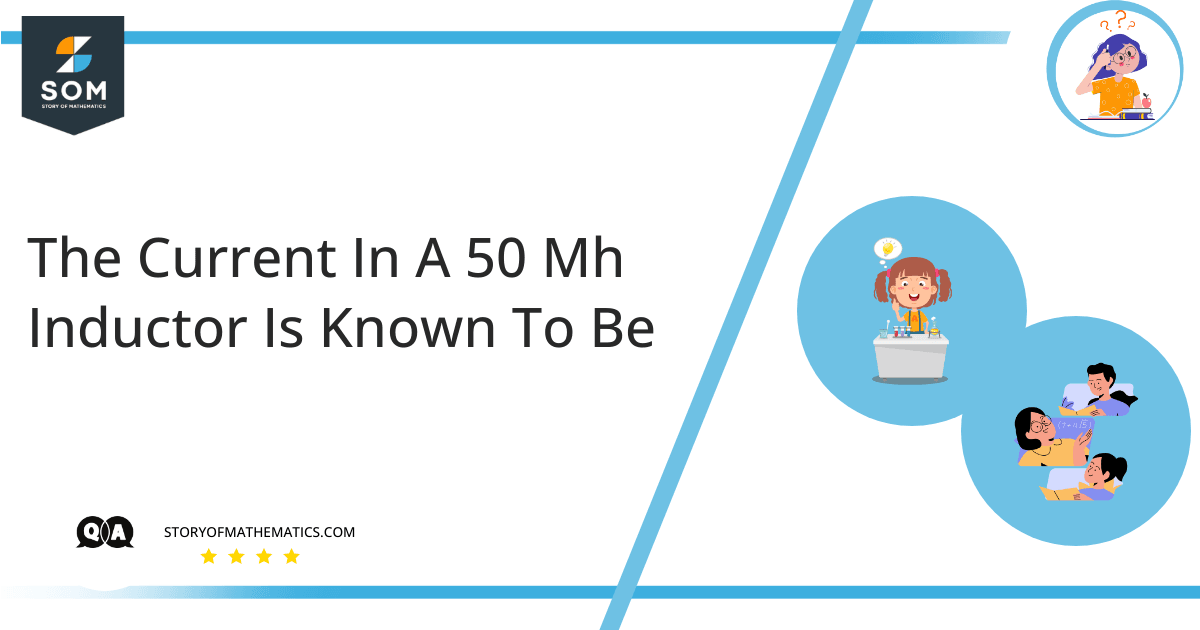 i = 120 mA, t<= 0
i = 120 mA, t<= 0
\[ \boldsymbol{ i(t) \ = \ A_1e^{ -500t } \ + \ A_2e^{ -2000t } \ A, \ t \ge 0 } \]
The potential difference across inductor terminals is 3V at time t = 0.
- Calculate the mathematical formula of the voltage for time t > 0.
- Calculate the time at which the inductor stored power decays to zero.
The aim of this question is to understand the current and voltage relationship of an inductor element.
To solve the given question we will use the mathematical form of the inductor voltage-current relationship:
\[ v(t) = L \dfrac{ di(t) }{ dt } \]
where, $L$ is the inductance of the inductor coil.
Expert Answer
Part (a): Calculating the equation of voltage across the inductor.
Given:
\[ i(t) \ = \ A_1e^{ -500t } \ + \ A_2e^{ -2000t } \]
At $ t \ = \ 0 $ :
\[ i(0) \ = \ A_1e^{ -500(0) } \ + \ A_2e^{ -2000(0) } \]
\[ i(0) \ = \ A_1 \ + \ A_2 \]
Substituting $ i(0) \ = \ 120 \ = \ 0.12 $ in above equation:
\[ A_1 \ + \ A_2 \ = \ 0.12 \ … \ … \ … \ (1) \]
Voltage of an inductor is given by:
\[ v(t) = L \dfrac{ di(t) }{ dt } \]
Substituting value of $ i(t) $
\[ v(t) = L \dfrac{ d }{ dt } \bigg ( A_1e^{ -500t } \ + \ A_2e^{ -2000t } \bigg ) \]
\[ v(t) = L \bigg ( -500A_1e^{ -500t } \ – \ 2000A_2e^{ -2000t } \bigg ) \]
\[ v(t) = ( 50 \times 10^{ -3 } ) \bigg ( -500A_1e^{ -500t } \ – \ 2000A_2e^{ -2000t } \bigg ) \]
\[ v(t) = -25A_1e^{ -500t } \ – \ 100A_2e^{ -2000t } \ … \ … \ … \ (2) \]
At $ t \ = \ 0 $ :
\[ v(0) = -25A_1e^{ -500( 0 ) } \ – \ 100A_2e^{ -2000( 0 ) } \]
\[ v(0) = -25A_1 \ – \ 100A_2 \]
Since, $ v(0) = 3 $, above equation becomes :
\[ -25A_1 \ – \ 100A_2 = 3 \ … \ … \ … \ (3) \]
Solving equations $1$ and $3$ simultaneously:
\[ A_1 = 0.2 \ and \ A_2 = -0.08 \]
Substituting these values in equation $2$:
\[ v(t) = -25(0.2)e^{ -500t } \ – \ 100(-0.08)e^{ -2000t } \]
\[ v(t) = -5e^{ -500t } \ + \ 8e^{ -2000t } \ V \]
Part(b): Calculating the time when the energy in the inductor becomes zero.
Given:
\[ i(t) \ = \ A_1e^{ -500t } \ + \ A_2e^{ -2000t } \]
Substituting values of constants:
\[ i(t) \ = \ 0.2 e^{ -500t } \ – \ 0.08 e^{ -2000t } \]
Energy is zero when the current becomes zero, so under the given condition:
\[ 0 \ = \ 0.2 e^{ -500t } \ – \ 0.08 e^{ -2000t } \]
\[ \Rightarrow 0.08 e^{ -2000t } \ = \ 0.2 e^{ -500t } \]
\[ \Rightarrow \dfrac{ e^{ e^{ -500t } }{ -2000t } } \ = \ \dfrac{ 0.08 }{ 0.2 } \]
\[ \Rightarrow e^{ 1500t } \ = \ 0.4 \]
\[ \Rightarrow 1500t \ = \ ln( 0.4 ) \]
\[ \Rightarrow t \ = \ \dfrac{ ln( 0.4 ) }{ 1500 } \]
\[ \Rightarrow t \ = \ -6.1 \times 10^{-4} \]
Negative time means that there is a continuous source of energy connected to the inductor and there is no plausible time when the power becomes zero.
Numerical Result
\[ v(t) = -5e^{ -500t } \ + \ 8e^{ -2000t } \ V \]
\[ t \ = \ -6.1 \times 10^{-4} s\]
Example
Given the following current equation, find the equation for the voltage for an inductor of inductance $ 1 \ H $:
\[ i(t) = sin(t) \]
Voltage of an inductor is given by:
\[ v(t) = L \dfrac{ di(t) }{ dt } \]
\[ \Rightarrow v(t) = (1) \dfrac{ d }{ dt } ( sin(t) ) \]
\[ \Rightarrow v(t) = cos(t) \]
